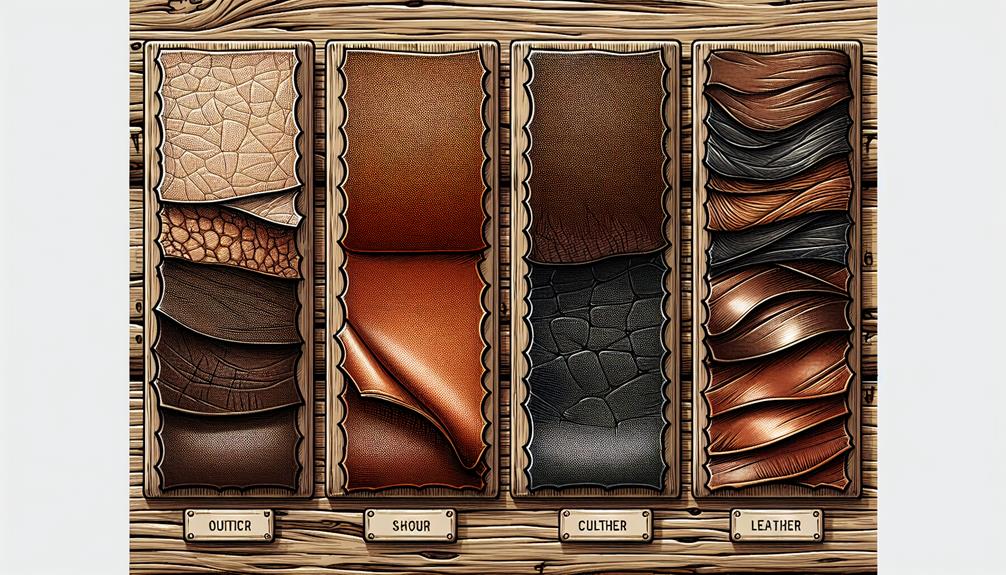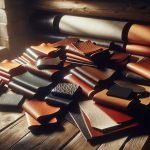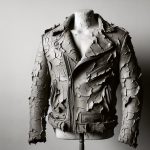When I learned about leather, I found out there are four main grades: full grain, top grain, genuine, and bonded. Full grain is the best, really tough and ages well. Top grain is also high quality but a bit more flexible. Genuine leather is more affordable but not as durable; it's made from leftovers. Bonded leather is the lowest grade, made from scraps and not very strong. Each type has its own pros and cons, and knowing them can help you make better choices depending on what you're after. Stick around and I'll show you how each one stands out!
Table of Contents
Key Takeaways
- Full grain leather is the highest quality, known for its durability and luxurious feel.
- Top grain leather is the second-highest quality, offering flexibility and smoothness.
- Genuine leather, made from leftover scraps, is the most accessible but lower in quality.
- Bonded leather, the lowest grade, combines leather scraps with polyurethane and is less durable.
- The grades vary in durability, appearance, and cost, accommodating different budgets and preferences.
Full Grain Leather Explained
Starting with Full Grain Leather, it's the top-tier choice known for its unbeatable quality and smooth feel. When you're after the highest quality leather, full grain stands out. It's not just durable; it's luxurious. The grain remains unaltered, keeping its fibers strong. That means it lasts a really long time.
This type of leather isn't just tough, it gets better with age. It develops a patina that's not only protective but also adds a unique beauty to each piece. Whether it's high-quality footwear or high-end furniture, full grain leather holds up and looks great.
Opting for full grain leather means you can choose finishes like aniline or semi-aniline. These treatments keep the leather's smooth surface, enhancing its natural markings without covering them up. It's perfect for anyone who appreciates craftsmanship and quality.
Understanding Top Grain Leather
Top grain leather, often seen as the second-best type after full grain, provides a smoother and more flexible option for many leather goods. It's the second-highest quality you can get, and it's way more pliable and thinner than its full grain cousin. They sand down the surface and slap on a finish coat, which gives it that smooth appearance everyone loves.
As it ages, top grain leather develops this cool protective patina, which isn't just about looks—it helps with stain resistance too. So, it's not only easier to take care of, but it's also more affordable. That's a win-win in my book!
Here's a quick breakdown in a table to paint the picture:
| Feature | Top Grain Leather | Benefits |
|---|---|---|
| Quality | Second-highest | Premium yet affordable |
| Flexibility | More pliable and thinner | Comfort and adaptability |
| Surface | Sanded with a finish coat | Smooth appearance |
| Durability | Develops a protective patina | Enhances stain resistance |
The Basics of Genuine Leather
While top grain leather offers a blend of quality and affordability, genuine leather steps in as the most accessible option in the market. Let's break it down.
Genuine leather, despite being real leather, is at the lowest quality tier. Why? Well, it's mostly made from leftover scraps. This means it can be stiff and not as durable as you'd hope.
Genuine leather is super common in products where cost matters a lot, like budget-friendly backpacks or basic belts. Don't expect it to last a lifetime, though. Its lifespan is shorter than pricier leathers, which is something to keep in mind if you're after something that'll age well.
However, it's not all bad news. If you're looking to get that leather look without shelling out big bucks, genuine leather's your go-to. It's a solid alternative that won't break the bank. Just remember that with this lower cost comes a trade-off in how long it'll look good and hold up. So, if you're fine with the downsides, genuine leather could really work for your needs, especially when sticking to a tight budget.
Bonded Leather Characteristics
Let's dive into bonded leather, known as the lowest grade of leather available. So, what's it all about? Bonded leather is a mix of leather scraps and polyurethane. It's kind of like the hotdog of the leather world — a little bit of everything.
This type of leather often finds its way into less visible spots. Think book covers or some cheaper furniture pieces. Now, why isn't it front and center? Well, it doesn't quite hold up. Bonded leather isn't famous for its durability. Over time, it tends to start peeling and showing signs of deterioration. Not exactly what you want from something that's supposed to handle daily use.
But hey, it's not all doom and gloom. Bonded leather has its perks. It's super affordable. When you're on a tight budget but want that leather look, it can be a go-to choice. Just keep in mind, you're trading off some quality and longevity for that lower price tag.
Understanding these characteristics is crucial. If you're looking into leather items, knowing what bonded leather offers helps you make smarter, more informed choices. No surprises, just clear expectations.
Frequently Asked Questions
What Are the 5 Grades of Leather?
The five grades of leather are full-grain, top-grain, split-grain, genuine, and bonded. Full-grain's the toughest, top-grain's more flexible, split-grain's used for suede, and bonded's the least natural but most affordable.
What Is the Cheapest Grade of Leather?
I've learned that the cheapest grade of leather is bonded leather. It's made from scraps and not very durable, so it often peels or cracks. It's budget-friendly but doesn't last long.
What Is the Highest Quality Type of Leather?
The highest quality type of leather is full grain leather. It's luxurious, durable, and ages beautifully. Ideal for high-end products, it retains the hide's natural texture and develops a unique patina.
What Grade Is Real Leather?
I've learned real leather includes several grades: Full Grain, Top Grain, Genuine, and Bonded Leather. For top quality, I'd choose Full Grain or Top Grain due to their durability and appearance.
- Is Tencel Lyocell Plastic? - April 19, 2024
- What Are the Disadvantages of Tencel? - April 19, 2024
- Is Tencel Lyocell a Good Fabric? - April 19, 2024






